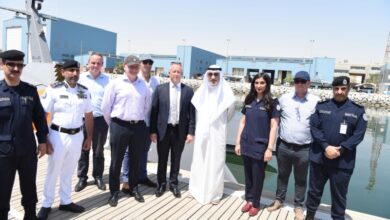Overcoming Kuwait’s persistent power crunch
Kuwait’s electric power generation capacity in 2021 was around 20 GW, but a growing population, development of new cities and industries, increase in power intensive water desalination processes, and higher summer temperatures have all combined to raise electricity consumption and strain the ability of existing power stations to cope with the demand.

The Times Kuwait Report
Electricity supply breakdowns from grid overload on days of high temperature, and appeals by the Ministry of Electricity, Water, and Renewable Energy (MEWRE), urging the public to reduce and rationalize electricity consumption, especially during peak temperature periods, have become a regular feature of summers in Kuwait.
Recurring power outages in summer are a searing reminder that, despite living in one of the wealthiest countries in the world, inefficient delivery and inadequate quality are the norm when it comes to public services in Kuwait. The almost ritual electricity blackouts and brownouts each year underscores the fact that existing power stations are largely incapable, and their output insufficient to meet the growing energy demands from new industries, residential cities, and an increasing population.
Officials at MEWRE claim that their recommendations and plans for increasing energy output by commissioning new power plants have been repeatedly ignored by the government. Inability of the ministry to win approval for its new power plants to meet increasing electricity demand, also mirrors the incapability of past governments to gain support from parliament for vital infrastructure and utility projects, due to political exigencies. Power shortfalls not only impair the daily life of people, they also significantly impact the economy.
Businesses and investors have long lamented the lack of priority accorded to power projects and pointed out how continued insufficiency in power supply could discourage investments in the country. It is not that the country lacks resources or technological access to address the energy situation, it is just that utility projects, along with all other project activities in Kuwait, have for far too long suffered from an ‘implementation inertia’.
There is clearly a dire need to increase electricity and water output to meet growing demand. Although Kuwait currently has sufficient electricity capacity, its peak demand during the hot summer months is reaching close to the country’s available capacity, and could soon strain the power system. Many of the existing utility plants also need to be replaced, as they have reached the end of their operational life, and continuing to operate and maintain them is increasingly becoming unviable.
Kuwait’s electric power generation capacity in 2021 was around 20 GW, but a growing population, development of new cities and industries, increase in power intensive water desalination processes, and higher summer temperatures have all combined to raise electricity consumption and strain the ability of existing power stations to cope with the demand. Industry experts say that utility projects shelved in the past would have together added around 13GW to the national grid.
Over the last few years, international developers have proposed several initiatives to expand current production capacity and efficiently address the country’s persistent power shortages. Many of the proposed projects were for constructing highly efficient combined-cycle natural gas-fired power generation units, while a few were for using solar energy to power electricity generation.
However, despite their significance to expanding power production, all of these proposals have been shelved by successive previous governments for various reasons, including lack of funds during economic downturns, regulatory and legal issues, bureaucratic hurdles, political stalemate in the National Assembly, or due to social and environmental concerns.
Most recently, media reports and industry sources indicated that several international companies had submitted initiatives to MEWRE under the independent water and power producer (IWPP) model. The proposals offered to produce energy and water at no cost to the state, and at a competitive price rate to consumers. However, no decisions have been made in this regard so far.
Many countries worldwide rely on IWPP schemes to build and operate utility projects that generate water and power to meet growing demand. Under the IWPP model, an international or local company receives approval from a public sector entity to finance, design, construct, own, and operate a utility facility for a set period of time, after which the facility returns to the public entity. IWPP developers make their money by selling the water and power produced, either directly to consumers, or to the public entity that commissioned the project, at pre-fixed stipulated rates. The IWPP model is cost-effective and ensures sufficient power and water supplies to meet local demand without any upfront expenses to the state. IWPP projects also attract international developers and investment to a country.
Several Gulf Cooperation Council (GCC) states have successfully launched IWPP projects in the past to meet their growing demand. Kuwait has been slow to follow suit, with the country continuing to rely on the traditional Engineering, Procurement, Construction (EPC) model for its infrastructure and utility projects. Although legal mechanisms for purchasing water and energy supplies from global investors and developers have existed since 2008, it is only in recent years that they have been actively pursued in Kuwait.
Some of the legal frameworks that govern the formation of Kuwaiti joint-stock companies for the development of water and power utility projects include BOT law No. 7 of 2008, which was replaced by the public-private partnership (PPP) law No. 116 of 2014, and the IWPP law No.39 of 2010, which was amended in 2012. The Kuwait Direct Investment Promotion Authority (KDIPA) is also authorized through Law No. 116 of 2013 to attract global IWPP developers.
More recently, degree No. 207 of 2023 and Cabinet Resolution No. 995 of 2023, specifically authorizes MEWRE to purchase energy from external sources using IWPP schemes. Despite the support of these legal frameworks, the only IWPP venture in Kuwait so far has been the Az-Zour North IWPP phase 1 project. A second project using the PPP model was used to procure the USD1.6 billion Umm Al Hayman wastewater treatment plant.
There is an urgent need to expedite the development of new utility projects using the IWPP model, and to create a business climate more attractive to global IWPP developers and investment. But Kuwait is yet to achieve the level of success in attracting IWPP developers as neighboring Saudi Arabia or the United Arab Emirates. And, there is no wonder why Kuwait has lagged others in this regard.
Recently, a local daily reported that the Norwegian company Scatec, an independent water and power producer which specializes in renewable energy, submitted an initiative to build a 1.3GW solar power station at no cost to the state. However, the proposal from Scatec did not elicit any positive response from the relevant authorities. After their initiative was ignored, Scatec withdrew its proposal and the country lost yet another global developer and investor.
On a related note, early last year reports emerged that the cabinet had endorsed a plan by MEWRE to restructure the ministry to an autonomous corporation with the mandate to establish separate companies for water, power, and renewable energy. The ministry also obtained necessary clearance from the Central Agency for Public Tenders to invite global consultancies to implement the restructuring plan.
The planned entity would be tasked to increase efficiency and streamline services, as well as work to lower costs, slash government subsidies, and aim to reduce and rationalize consumption of water and power. But since then, there has been no update on the status of this corporation. Executive and legislative authorities have blamed each other over the years for the delay in power project activities.
Irrespective of who is responsible for failing to address the energy deficit in the past, the new government in office needs to prioritize long-term solutions to the country’s persistent power crunch and prioritize the launch of new utility projects, so as to ensure that citizens and residents will no longer need hand-fans to cool themselves in summer.














